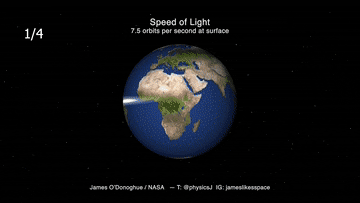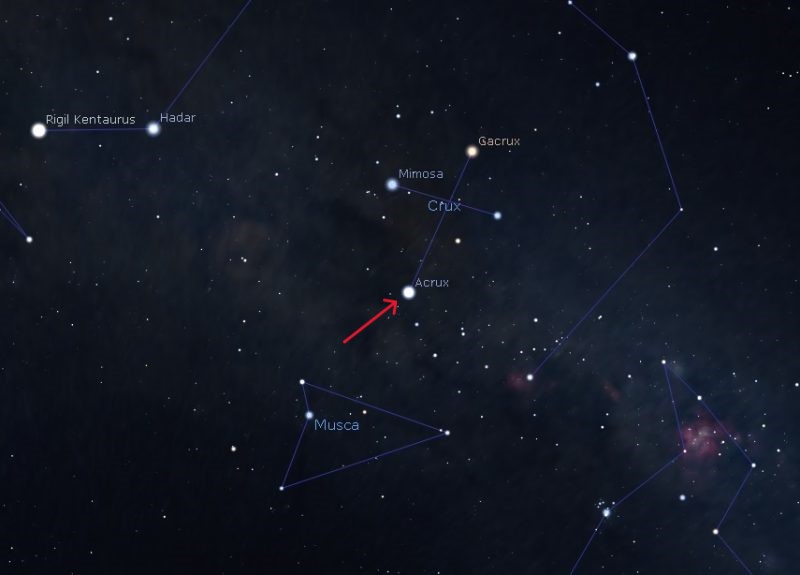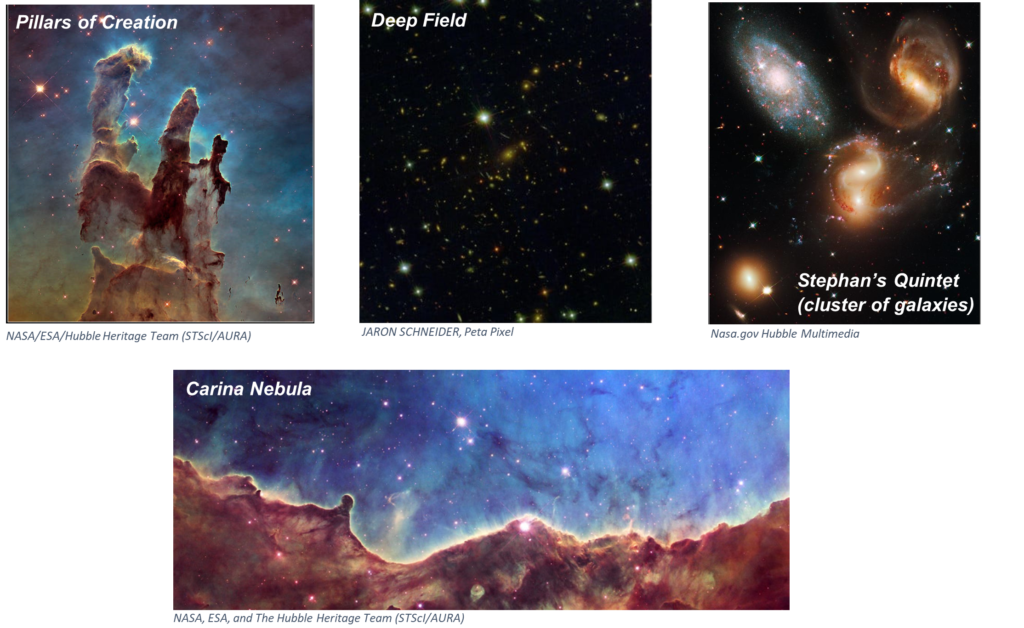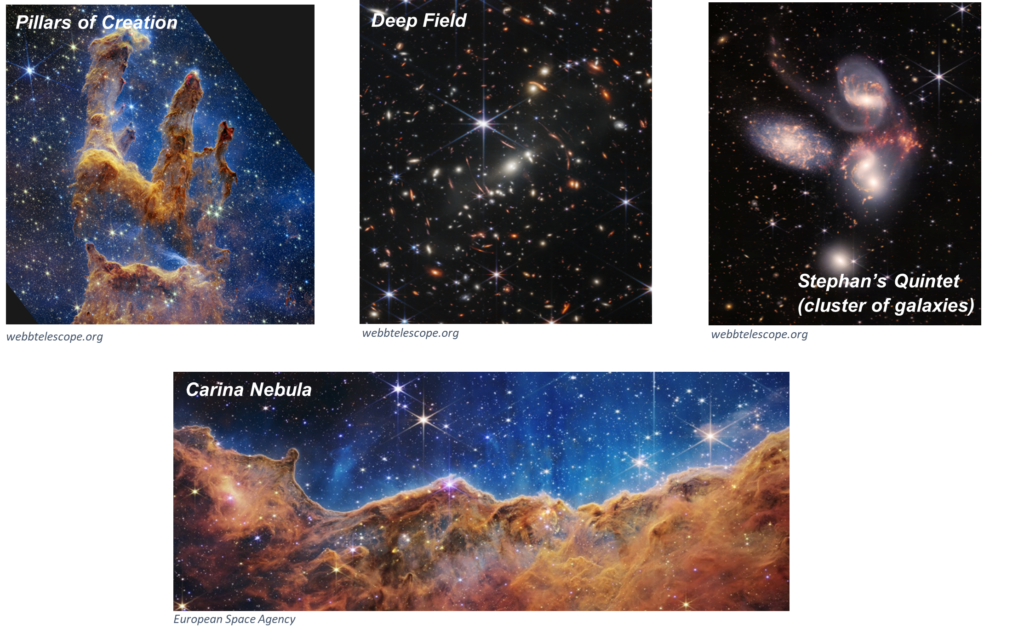Have you ever looked out to the night sky?
I mean REALLY looked. Paused for a long moment and stared at all of those small specks of light. Stars, galaxies, planets, and clusters. Quite wonderful, isn’t it?
SPOILER ALERT: You are looking at what these stars and galaxies USED to look like a long, long time ago. Hold on to those stars and let me explain.
Too fast or not fast enough?
Ever turned on a torch to a wall? Light travels from the torch to the wall so fast that our eyes can’t pick it up.
With a speed of 300,000 kilometres per second, light can go around the Earth and come back in just 0.13 seconds! If you shine a light to the moon, it will reach it in just over 1 second. Yes, light is the fastest thing in the universe, according to Einstein and physics – although The Flash can travel faster than light, but let’s leave that for the superhero comic fans like me.
So light is speedy right?
Take a look at the animation below. It compares how long (in real time) light travels around earth (1/4), to the Moon (2/4), to Mars (3/4) and from the Sun to us (4/4).

No, light isn’t slowing down. It’s still travelling at a whopping 300,000 km/s, but Space is so big and SPACIOUS (pun intended) that even light takes way too long to get to different places.
For example, if a person on Earth wants to send a radio signal (travelling at the speed of light) to someone all the way on Neptune, it would take about 4 hours to reach them. Imagine waiting 4 hours for them to receive “Hello” and then another 4 hours to hear “Hello” back!
Back to the stars.
If it takes 4 hours for light to travel from Neptune to us, imagine the stars and galaxies that are billions of times further away.
Let’s start small. The closest star to us (other than the sun) is Proxima Centauri. This star is about 4 light-years away from Earth.
“Wait, what in the Venus is light-years?”
A light-year is the distance that light can travel in one year (about 9.46 trillion km).
So, when we say Proxima Centauri is 4 light-years away, that means it takes light 4 years to travel from that star to us. In other words, when you look at Proxima Centauri you’re seeing what it looked like 4 years ago, because the light particles you see right now left the star 4 years ago. And this is only the closest star.
You’ve probably seen the Southern Crux constellation – yes, the famous one in the Australian flag. Did you know that the star at the bottom (Acrux) is 323 light-years away? Light travels for over three hundred years to reach us from that star!

Think about this: if Acrux suddenly went into supernova (exploded) right now, we would have no idea because we wouldn’t see the explosion for another 323 years – in the year 2346!
Mind-blown yet?
Think about this next time you look up at the stars, because you’re actually looking at the past. You may not be time-travelling, but you’re able to see through time and you have to admit, that’s pretty awesome.
Why is this important?
Some might think that not being able to see the universe as it looks in the present might be inconvenient for studying it. But this is actually a special advantage and let me tell you why.
Say you want to get to know someone and learn all about who they are. The biggest questions you’ll ask will be regarding their past, their childhood, where they came from, what their parents did, what their grandparents did, etc. Or if you want to know more about a viral song, you’d search for information about the songwriter, what they do and how they came to write the lyrics. The same goes for everything, this is because the origins of someone or something is a crucial part and tells you a lot about how it came to be the way it is today.
The same reason is why one of life’s biggest unsolved questions is ‘How did the universe start?’, “What was there before it came into existence?” The study of cosmology deals with such questions. We want to explore where we came from, where we’re going and what our place in the universe is.
So, when you really think about it, the fact that we can see stars and galaxies like they used to look like a very long time ago, we’re able to study the universe’s early days shortly after the big bang. Kind of like being able to see what someone was like as a newborn without having to travel back in time!
Wait, are we actually doing this?
While yes, observing light from objects extremely far away using Earth telescopes works, a better way to do this is to send a telescope to Space. That’s what we call a Space Telescope, and it’s a powerful machine that orbits in Space while processing light and sending us images of the universe.
Ever hear of the James Webb Space Telescope? No? Well strap in, I’m about to blast you away.

The James Webb Space Telescope (JWST) is the largest and most powerful Space telescope to date. It has only spent a year in Space now but has provided us with the highest quality images of the universe we have seen so far.
First, take in the beauty of the images below for a moment.

Beautiful right? The images above are from the Hubble Space telescope (an older telescope operating in Space). But now look at the exact same images below that are taken by the James Webb Space Telescope and compare the difference! I’ll give you a moment to recover from these dazzling photos.

Very old light
Now the light from these places in the universe took various millions of years to reach us. Let’s look at one my favourite images from the JWST – the Deep Field image.
A deep field is a photo taken of tremendously far away objects, using long exposure of such faint light. The particular deep field above taken by the JWST is one of the furthest away we’ve seen in our universe ever. Can you guess how far away some of those galaxies are?
Over 13 billion light years away.
Yes, light travelled that long to reach us. If the Big Bang estimated to have happened 13.8 billion years ago, we are basically looking at high-definition images of a very early infant universe! A step closer to understanding the origins of the universe and answering big questions.
Who is involved with all of this?
The James Webb Telescope is a project that involved thousands of Space Jobs. But what comes to your mind when you hear the term ‘Space Job’?
Astronauts, Engineers, Astronomers, and Scientists, right?
But there’s much more.
This is a common misconception about ‘Space Jobs’. What many aren’t aware of is how broad and diverse Space Jobs actually are. You can’t have a successful Space Mission without thousands of people from different fields working together. Yes, Astronauts are the ones going to Space, and Engineers are needed to build the rockets, but who will manage these big Space missions? Who will analyse rocks we find on the moon? Who will photograph and document important parts of a mission?
That would be Space project managers, Space Geologists, Space Media Photographers.
And to throw in more examples; did you know we need Space Psychologists to study the effects of Space travel on our mental health, Space Operators to control and track satellites and space junk, and Space Intelligent game developers to build Virtual Reality programs for Space environment simulations? And there’s heaps more!
How do you fit in all of this?
You’ve made it to the last section of this article, congrats! But what’s all this Space Job talk got to do with you?
Well, the Space industry is growing rapidly at the moment, specifically here in Australia. The Australian Space Agency has a strategic plan to triple the size of the Space Sector in Australia by the year 2030!
This is where you can play a role to contribute to Australia making history in Space, and the cool part is you don’t have to be pursuing Engineering or Astrophysics or be a big space nerd to work in the Space field. You might have a passion for business and entrepreneurship, or have an interest in archaeology, or even enjoy playing video games and want to one day work in game development. Whatever it is, you can link it to Space and end up in the fastest-growing industry, while we are in an exciting age of Space Exploration!
About The Author

Shaghaf is a third-year Mechanical and Aerospace Engineering student at The University of Adelaide. She is a Space Enthusiast and sometimes a little too talkative.
But Shaghaf didn’t grow up with Astronaut dreams or space-themed birthday parties. It was only in year 12 when Shaghaf was sitting in a physics class, and learnt about Einstein’s Theory of Relativity and Space-time, that she fell in love with Space Science.
As she is pursuing a career in the Aerospace Engineering industry, Shaghaf works at the Australian Space Discovery Centre as a Space Communicator (And you can visit to say hi to any of the friendly staff during open hours for free!). She is also involved with several extra-curriculars such as the Adelaide University Space Society, and the Astra Program.
If you have any burning questions for Shaghaf, especially the Space-related ones, you can reach her at [email protected].